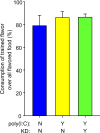Ketogenic diet improves behaviors in a maternal immune activation model of autism spectrum disorder
- PMID: 28166277
- PMCID: PMC5293204
- DOI: 10.1371/journal.pone.0171643
Ketogenic diet improves behaviors in a maternal immune activation model of autism spectrum disorder
Abstract
Prenatal factors influence autism spectrum disorder (ASD) incidence in children and can increase ASD symptoms in offspring of animal models. These may include maternal immune activation (MIA) due to viral or bacterial infection during the first trimesters. Unfortunately, regardless of ASD etiology, existing drugs are poorly effective against core symptoms. For nearly a century a ketogenic diet (KD) has been used to treat seizures, and recent insights into mechanisms of ASD and a growing recognition that immune/inflammatory conditions exacerbate ASD risk has increased interest in KD as a treatment for ASD. Here we studied the effects of KD on core ASD symptoms in offspring exposed to MIA. To produce MIA, pregnant C57Bl/6 mice were injected with the viral mimic polyinosinic-polycytidylic acid; after weaning offspring were fed KD or control diet for three weeks. Consistent with an ASD phenotype of a higher incidence in males, control diet-fed MIA male offspring were not social and exhibited high levels of repetitive self-directed behaviors; female offspring were unaffected. However, KD feeding partially or completely reversed all MIA-induced behavioral abnormalities in males; it had no effect on behavior in females. KD-induced metabolic changes of reduced blood glucose and elevated blood ketones were quantified in offspring of both sexes. Prior work from our laboratory and others demonstrate KDs improve relevant behaviors in several ASD models, and here we demonstrate clear benefits of KD in the MIA model of ASD. Together these studies suggest a broad utility for metabolic therapy in improving core ASD symptoms, and support further research to develop and apply ketogenic and/or metabolic strategies in patients with ASD.
Conflict of interest statement
The authors have declared that no competing interests exist.
Figures




Similar articles
-
The effect of ketogenic diet in an animal model of autism induced by prenatal exposure to valproic acid.Nutr Neurosci. 2017 Jul;20(6):343-350. doi: 10.1080/1028415X.2015.1133029. Epub 2016 Feb 8. Nutr Neurosci. 2017. PMID: 26856821
-
Exogenous PD-L1 binds to PD-1 to alleviate and prevent autism-like behaviors in maternal immune activation-induced male offspring mice.Brain Behav Immun. 2024 Nov;122:527-546. doi: 10.1016/j.bbi.2024.08.042. Epub 2024 Aug 23. Brain Behav Immun. 2024. PMID: 39182588
-
Oral probiotic administration during pregnancy prevents autism-related behaviors in offspring induced by maternal immune activation via anti-inflammation in mice.Autism Res. 2019 Apr;12(4):576-588. doi: 10.1002/aur.2079. Epub 2019 Jan 25. Autism Res. 2019. PMID: 30681777
-
[Impact of Maternal Stress in Pregnancy on Brain Function of the Offspring].Nihon Eiseigaku Zasshi. 2016;71(3):188-194. doi: 10.1265/jjh.71.188. Nihon Eiseigaku Zasshi. 2016. PMID: 27725421 Review. Japanese.
-
Maternal IL-17A in autism.Exp Neurol. 2018 Jan;299(Pt A):228-240. doi: 10.1016/j.expneurol.2017.04.010. Epub 2017 Apr 25. Exp Neurol. 2018. PMID: 28455196 Free PMC article. Review.
Cited by
-
Adult Inception of Ketogenic Diet Therapy Increases Sleep during the Dark Cycle in C57BL/6J Wild Type and Fragile X Mice.Int J Mol Sci. 2024 Jun 18;25(12):6679. doi: 10.3390/ijms25126679. Int J Mol Sci. 2024. PMID: 38928388 Free PMC article.
-
The early life exposome and autism risk: a role for the maternal microbiome?Gut Microbes. 2024 Jan-Dec;16(1):2385117. doi: 10.1080/19490976.2024.2385117. Epub 2024 Aug 9. Gut Microbes. 2024. PMID: 39120056 Free PMC article. Review.
-
Ketogenic Diet Affects Sleep Architecture in C57BL/6J Wild Type and Fragile X Mice.Int J Mol Sci. 2023 Sep 22;24(19):14460. doi: 10.3390/ijms241914460. Int J Mol Sci. 2023. PMID: 37833907 Free PMC article.
-
Diet in treatment of autism spectrum disorders.Front Neurosci. 2023 Jul 10;16:1031016. doi: 10.3389/fnins.2022.1031016. eCollection 2022. Front Neurosci. 2023. PMID: 37492195 Free PMC article. Review.
-
Neuroinflammation and Oxidative Stress in the Pathogenesis of Autism Spectrum Disorder.Int J Mol Sci. 2023 Mar 13;24(6):5487. doi: 10.3390/ijms24065487. Int J Mol Sci. 2023. PMID: 36982559 Free PMC article. Review.
References
-
- Masino SA, Fortin JA, Murphy MI, Saa L, Ruskin DN. Autism Spectrum Disorder and Homeostasis In: Boison D, Masino SA, editors. Homeostatic Control of Brain Function. New York: Oxford University Press; 2015. p. 586–609.
-
- Patterson PH. Maternal infection: window on neuroimmune interactions in fetal brain development and mental illness. Curr Opin Neurobiol. 2002;12:115–8. - PubMed
MeSH terms
Substances
Grants and funding
LinkOut - more resources
Full Text Sources
Other Literature Sources
Medical

